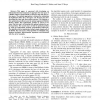29 search results - page 5 / 6 » Dynamic Programming Approximations for Partially Observable ... |
AAAI
2008
13 years 10 months ago
2008
This paper examines, by argument, the dynamics of sequences of behavioural choices made, when non-cooperative restricted-memory agents learn in partially observable stochastic gam...
ECCV
2004
Springer
14 years 9 months ago
2004
Springer
We present a vision based, adaptive, decision theoretic model of human facial displays in interactions. The model is a partially observable Markov decision process, or POMDP. A POM...
CPAIOR
2008
Springer
13 years 9 months ago
2008
Springer
The one-step anticipatory algorithm (1s-AA) is an online algorithm making decisions under uncertainty by ignoring future non-anticipativity constraints. It makes near-optimal decis...
CDC
2010
IEEE
13 years 2 months ago
2010
IEEE
This paper is concerned with developing an information-theoretic framework to aggregate the state space of a Hidden Markov Model (HMM) on discrete state and observation spaces. The...
BMCBI
2005
13 years 7 months ago
2005
Background: Ambiguity is a problem in biosequence analysis that arises in various analysis tasks solved via dynamic programming, and in particular, in the modeling of families of ...

